【翻译】中国鸟类新纪录
- 格式:doc
- 大小:232.50 KB
- 文档页数:3

黄河三角洲发现的山东省鸟类新纪录单凯;于君宝【摘要】以郑光美2011年第二版《中国鸟类分类与分布名录》所录鸟种为参照,根据连续多年的定点观察、鸟类专项调查及当地鸟类野外拍摄照片确认鸟类种类.研究结果证实在黄河三角洲发现的山东省鸟类新纪录为24种,对发现的鸟类新纪录以最近5年的野外观察为基础对其频度进行评估,确定居留型,并对其分布习性进行描述,从而为山东省鸟类研究提供资料.【期刊名称】《四川动物》【年(卷),期】2013(032)004【总页数】4页(P609-612)【关键词】黄河三角洲;山东省鸟类;新纪录【作者】单凯;于君宝【作者单位】山东黄河三角洲国家级自然保护区管理局,山东东营257091;中国科学院海岸带环境过程重点实验室(烟台海岸带研究所),山东烟台264003【正文语种】中文【中图分类】Q959.7山东地处暖温带和滨海地带,是许多鸟类南北迁飞必经之路。
自19世纪中期起Swinhoe等研究者陆续有山东鸟类种类与分布的报道。
寿振黄于1930年在国内首次系统报道了山东鸟类区系。
自1959年起,山东的动物学工作者开始不断报道山东的鸟类记录(柏玉崑,纪加义,1982;纪加义等,1987a,1987b),1983年山东省林业厅主持了“山东省鸟类资源普查”项目,1983~1986年进行了连续3年的鸟类普查,调查结果以《山东省鸟类资源普查报告》公布,记录鸟类408种和亚种,其中候鸟有358种和亚种,留鸟50种和亚种,有73种和亚种在过去存在于山东的鸟类在普查中未被发现(纪加义等,1987a,1987b)。
1986年鸟类普调以来,国内外学者又发表了一些山东鸟类的新纪录,至2000年底,国内外记录过的山东鸟类名录已达427种和亚种,其中22种证明在山东无分布或疑已消失,山东现有鸟类记录实为405种和亚种(卢浩泉,王玉志,2003)。
2012年《山东野生鸟类》记录20目75科470种,其中山东省新纪录35种(桑新华,2012)。

近年来中国鸟类野外新纪录的解析近年来中国鸟类野外新纪录的解析如下:
近年来中国鸟类野外新纪录,在中国记录的野生鸟类物种数一直处于增长之中,特别是在2005年《中国鸟类分类与分布名录》第一版出版之后到2013年,又有多个中国鸟类新记录被发现。
有部分新纪录已经被收录到2011年出版的《中国鸟类分类与分布名录》第二版之中,但一些新纪录在中国的记录状况、分布等信息还不为广大鸟类学工作者所熟知。
本文对这些纪录的分类、分布状况进行了系统性总结,在总结的基础上我们发现,在这些新纪录主要分布于三个热点地区,包括西部边境省区(新疆、西藏、云南、广西),沿海三省市(河北、天津、福建)及台湾。
其中,出现在西部的新纪录物种的已知分布区邻近中国,部分种类极可能在中国境内繁殖、越冬和过境;而来自沿海和台湾的新纪录物种原有分布区距离中国较远,在中国多为偶见的迷鸟。
未来这些地区仍将是产生中国新纪录的热点地区。

贵州雷公山国家级自然保护区鸟类新纪录——红翅凤头鹃和灰斑鸠[简要]笔者于2020年9月20日和10月27日,分别在贵州雷公山国家级自然保护区内拍摄到两只鸟。
经查阅有关文献和相关专家鉴定,分别确定为红翅凤头鹃(Clamator coromandus)和灰斑鸠(Streptopelia decaocto),系贵州雷公山国家级自然保护区鸟类新纪录。
[关键词]红翅凤头鹃;灰斑鸠;鸟类;贵州雷公山国家级自然保护区;新纪录贵州雷公山国家级自然保护区位于贵州省黔东南中部,于1982年6月经贵州省人民政府批准建立,2001年6月经国务院批准晋升为国家级自然保护区, 2007年11月加入中国人与生物圈保护区网络。
地跨雷山、台江、剑河、榕江4县,地理位置东经108°5'—108°24',北纬26°15'—26°32',区内最高海拔2178.8m,最低海拔650m,东西横延约15km,南北纵深约30km。
总面积4.73万hm²,区内生物资源丰富,已鉴定的生物种类达5147种,其中:动物2291种(国家重点保护野生动物35种),高等植物2593种,大型真菌263种[2][3]。
2020年9月20日,笔者在贵州雷公山国家级自然保护区管理局院楼(E108°9'30.234",N26°22'49.9224" )下,发现一只身体还有余温的死鸟,经查看全身,除了头部有血迹外未发现其它部位受伤,可能是撞到玻璃窗致死。
经将照片与《中国鸟类识别手册》[1]核对,确定为红翅凤头鹃(Clamator coromandus)见图1图2。
图1:笔者在雷公山保护区管理局院坝拾到头部有血迹的红翅凤头鹃图2:这是笔者将捡到的红翅凤头鹃进行摆拍2020年10月27日14时10分,笔者在贵州雷公山国家级自然保护区管理局副局长王雄伟的带队下,与同事吴必锋、余永富、顾先元一起到辖区巡山护林,当来到白岩检查站下方一条步道(E108°9'23.1912",N26°22'56.0844")上,走在最前面的雷公山管理站顾先元站长发现不远处,一只野鸟正在觅食,激动地道:“宗才,快点来,这里有一只鸟”。
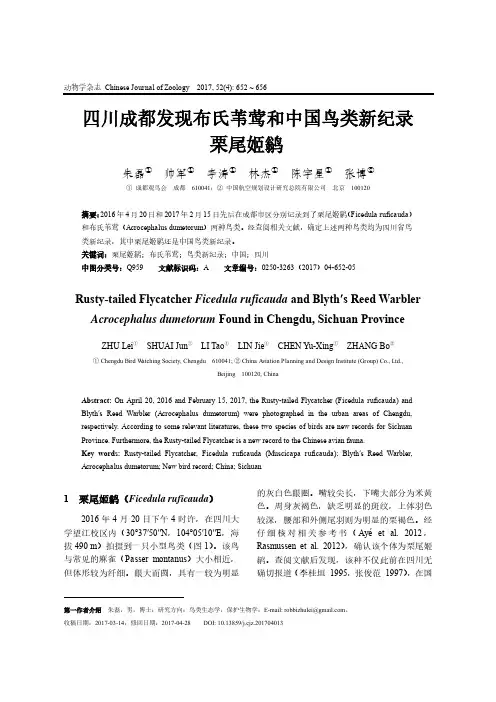
四川成都发现布氏苇莺和中国鸟类新纪录栗尾姬鹟朱磊① 帅军① 李涛① 林杰① 陈宇星① 张博②① 成都观鸟会 成都 610041;② 中国航空规划设计研究总院有限公司 北京 100120摘要:2016年4月20日和2017年2月15日先后在成都市区分别记录到了栗尾姬鹟(Ficedula ruficauda )和布氏苇莺(Acrocephalus dumetorum )两种鸟类。
经查阅相关文献,确定上述两种鸟类均为四川省鸟类新纪录,其中栗尾姬鹟还是中国鸟类新纪录。
关键词:栗尾姬鹟;布氏苇莺;鸟类新纪录;中国;四川中图分类号:Q959 文献标识码:A 文章编号:0250-3263(2017)04-652-05Rusty-tailed Flycatcher Ficedula ruficauda and Blyth ′s Reed Warbler Acrocephalus dumetorum Found in Chengdu, Sichuan ProvinceZHU Lei ①SHUAI Jun ①LI Tao ①LIN Jie ①CHEN Yu-Xing ①ZHANG Bo ②① Chengdu Bird Watching Society , Chengdu 610041; ② China Aviation Planning and Design Institute (Group ) Co., Ltd.,Beijing 100120, ChinaAbstract: On April 20, 2016 and February 15, 2017, the Rusty-tailed Flycatcher (Ficedula ruficauda ) and Blyth ′s Reed Warbler (Acrocephalus dumetorum ) were photographed in the urban areas of Chengdu, respectively. According to some relevant literatures, these two species of birds are new records for Sichuan Province. Furthermore, the Rusty-tailed Flycatcher is a new record to the Chinese avian fauna.Key words: Rusty-tailed Flycatcher, Ficedula ruficauda (Muscicapa ruficauda ); Blyth ′s Reed Warbler, Acrocephalus dumetorum ; New bird record; China; Sichuan第一作者介绍 朱磊,男,博士;研究方向:鸟类生态学,保护生物学;E-mail: robbizhulei@ 。

中国鸟类一新纪录(鸟纲:红鹳目:红鹳科)
马鸣;林纪春;张赋华
【期刊名称】《动物分类学报》
【年(卷),期】2000(025)002
【摘要】@@ 1997年9月和11月在参加新疆野生动物考察期间,从哈密林业局和乌鲁木齐机场得到大红鹳的照片、资料和标本.当时认为是偶然逸出的个体.通过1998年深入调查,又在不同地点获得了2号大红鹳标本,由此证实为我国鸟类1新纪录.
【总页数】2页(P238-239)
【作者】马鸣;林纪春;张赋华
【作者单位】中国科学院新疆生态与地理研究所乌鲁木齐 830011;新疆地方病防治研究所乌鲁木齐 830002;新疆哈密地区野生动物保护办公室哈密 839000【正文语种】中文
【中图分类】Q95
【相关文献】
1.内蒙古鸟类新纪录——大红鹳 [J], 方海涛;冯桂林
2.宁夏鸟类新纪录——大红鹳 [J], 张大治;王杰;杨贵军;程小龙;宽容
3.北京市鸟类新纪录——大红鹳 [J], 陈颀;张树苗;朱冰润;郭耕
4.崇明东滩鸟类新纪录——大红鹳 [J], 徐曦; 罗祖奎; 冉景丞
5.崇明东滩鸟类新纪录——大红鹳 [J], 徐曦; 罗祖奎; 冉景丞
因版权原因,仅展示原文概要,查看原文内容请购买。
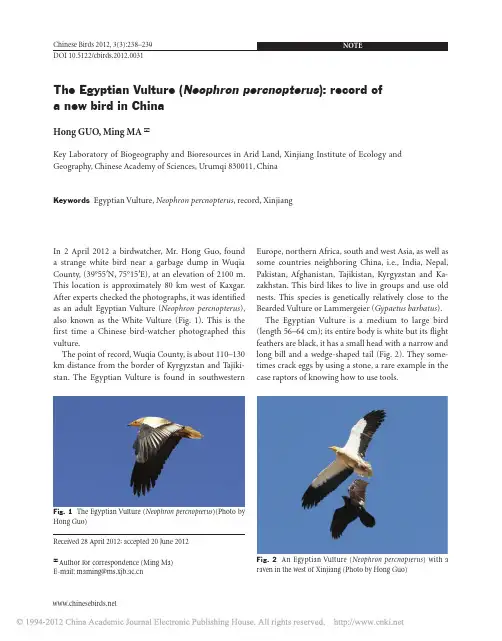
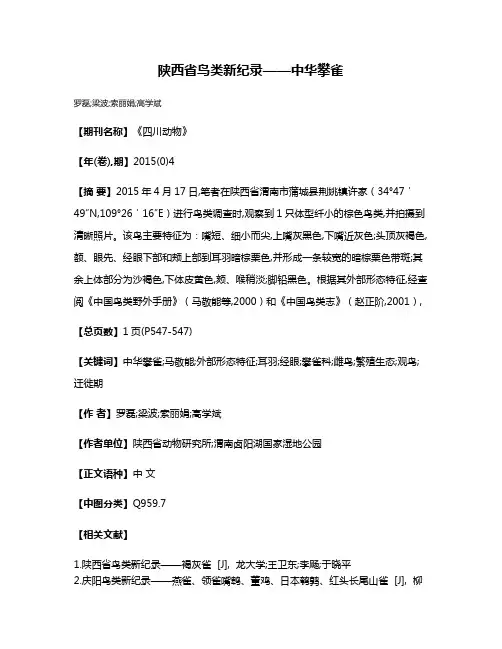
陕西省鸟类新纪录——中华攀雀
罗磊;梁波;索丽娟;高学斌
【期刊名称】《四川动物》
【年(卷),期】2015(0)4
【摘要】2015年4月17日,笔者在陕西省渭南市蒲城县荆姚镇许家(34°47'49″N,109°26'16″E)进行鸟类调查时,观察到1只体型纤小的棕色鸟类,并拍摄到清晰照片。
该鸟主要特征为:嘴短、细小而尖,上嘴灰黑色,下嘴近灰色;头顶灰褐色,额、眼先、经眼下部和颊上部到耳羽暗棕栗色,并形成一条较宽的暗棕栗色带斑;其余上体部分为沙褐色,下体皮黄色,颏、喉稍淡;脚铅黑色。
根据其外部形态特征,经查阅《中国鸟类野外手册》(马敬能等,2000)和《中国鸟类志》(赵正阶,2001),【总页数】1页(P547-547)
【关键词】中华攀雀;马敬能;外部形态特征;耳羽;经眼;攀雀科;雌鸟;繁殖生态;观鸟;迁徙期
【作者】罗磊;梁波;索丽娟;高学斌
【作者单位】陕西省动物研究所;渭南卤阳湖国家湿地公园
【正文语种】中文
【中图分类】Q959.7
【相关文献】
1.陕西省鸟类新纪录——褐灰雀 [J], 龙大学;王卫东;李飏;于晓平
2.庆阳鸟类新纪录——燕雀、领雀嘴鹎、董鸡、日本鹌鹑、红头长尾山雀 [J], 柳
鹏飞; 张娟丽; 杨永鹏; 韩亚鹏; 周天林
3.鸟类建筑师:中华攀雀 [J], 张周;范怀良
4.四川省鸟类新记录——中华攀雀 [J], 沈雨默;李一凡;胡明镜;李昭成
5.陕西省鸟类新纪录——黄颈拟蜡嘴雀 [J], 罗磊;韩宁;张宏;侯玉宝;高学斌
因版权原因,仅展示原文概要,查看原文内容请购买。
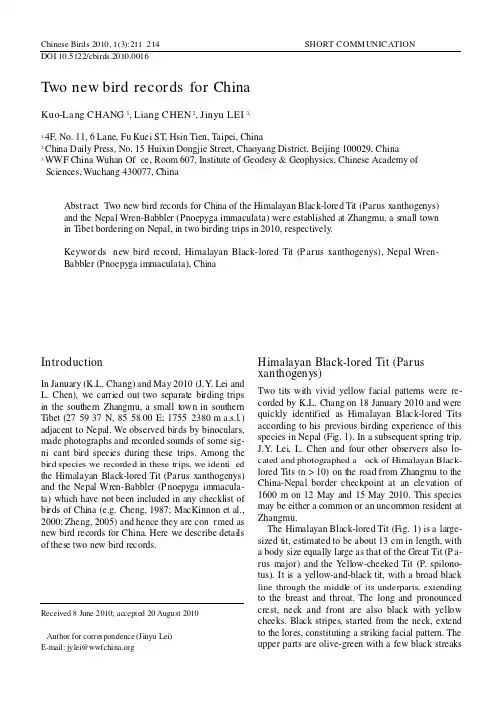
Chinese Birds 2010,1(3):211–214DOI 10.5122/cbirds.2010.0016SHORT COMMUNICATIONReceived 8June 2010;accepted 20August 2010Author for correspondence (Jinyu Lei)E-mail:jylei@Two new bird records for ChinaKuo-La ng CHANG 1,Liang CHEN 2,Jinyu LEI 3,14F,No.11,6Lane,Fu Kuei ST,Hsin Tien,Taipei,China2China Daily Press,No.15Huixin Dongjie Street,Chaoyang District,Beijing 100029,China 3WWF China Wuhan Of ce,Room 607,Institute of Geodesy &Geophysics,Chinese Academy of Sciences,Wuchang 430077,ChinaAbst ract Two new bird records for China of the Himalayan Black-lored Tit (Parus xanthogenys)and the Nepal Wren-Babbler (Pnoepyga immaculata)were established at Zhangmu,a small town in Tibet bordering on Nepal,in two birding trips in 2010,respectively.Keywor ds new bird record,Himalayan Black-lored Tit (P arus xanthogenys),Nepal Wren-Babbler (Pnoepyga immaculata),ChinaIntroductionIn January (K.L.Chang)and May 2010(J.Y .Lei and L.Chen),we carried out two separate birding trips in the southern Zhangmu,a small town in southern Tibet (27°59′37′′N,85°58′00′′E;1755–2380m a.s.l.)adjacent to Nepal.We observed birds by binoculars,made photographs and recorded sounds of some sig-ni cant bird species during these trips.Among thebird species we recorded in these trips,we identi edthe Himalayan Black-lored Tit (Parus xanthogenys)and the Nepal Wren-Babbler (P noepyga immacula-ta)which have not been included in any checklist of birds of China (e.g.Cheng,1987;MacKinnon et al.,2000;Zheng,2005)and hence they are con rmed as new bird records for China.Here we describe details of these two new bird records.Himalayan Black-lored Tit (Parus xanthogenys)Two tits with vivid yellow facial patterns were re-corded by K.L.Chang on 18January 2010and were quickly identified as Himalayan Black-lored Tits according to his previous birding experience of this species in Nepal (Fig.1).In a subsequent spring trip,J.Y .Lei,L.Chen and four other observers also lo-cated and photographed a ock of Himalayan Black-lored Tits (n >10)on the road from Zhangmu to the China-Nepal border checkpoint at an elevation of 1600m on 12May and 15May 2010.This species may be either a common or an uncommon resident at Zhangmu.The Himalayan Black-lored Tit (Fig.1)is a large-sized tit,estimated to be about 13cm in length,with a body size equally large as that of the Great Tit (P a-rus major)and the Y ellow-cheeked Tit (P.spilono-tus).It is a yellow-and-black tit,with a broad blackline through the middle of its underparts,extendingto the breast and throat.The long and pronounced crest,neck and front are also black with yellow cheeks.Black stripes,started from the neck,extend to the lores,constituting a striking facial pattern.The upper parts are olive-green with a few black streaksChinese Birds2010,1(3):211–214 212con ned to the scapulars.It resembles the Yellow-cheeked Tit(P.spilonotus),probably its closest rela-tive,as well as the other yellow-and-crested tit in the Himalayas,but this latter bird apparently lacks black in its forehead and lores.Females and young birds are reported to be duller in color than males(Grim-mett et al.,1999;Rasmussen and Anderton,2005). The ock we observed may have been a mixture of both males and female-like birds.This species is a common resident in open tropical forests,secondary forests and edges of dense forests and groves of the Indian subcontinent,from north Pakistan through the Himalayas to eastern Nepal (Grimmett et al.,1999;Rasmussen and Anderton, 2005).Three subspecies were described under the species level,the nominate races xanthogenys,aplo-notus and travancoreensis(Grimmett et al.,1999; Rasmussen and Anderton,2005).Based on evidence of morphology and vocalization,Rasmussen and An-derton(2005)proposed that xanthogenys and the two other subspecies should be treated as two species: the Himalayan Black-lored Tit(Parus xanthogenys) (monotypic)and the India Black-lored Tit(P.aplo-notus),with subspecies aplonotus and travancoreen-sis.Gill(2010)adopted this taxonomic treatment in the IOC W orld Bird N ames.The location where we sighted the birds,our eld description and morpho-logical characteristics shown in the photographs, explicitly match the diagnosis of the taxon xanthog-enys.Following Gill(2010),we therefore con rm that our sighting of the Himalayan Black-lored Tit (P.xanthogenys)is a new record for this bird species in China.Nepal Wren-Babbler(Pnoepyga immaculata)On8May2010,near the Zhangmu Hotel we heard a series of high-pitched metallic notes,like“tsi-tsu-tsi-tsi-tsu-tsi-tsi-tsi”,speeding up at the end and repeating several times.W e then recorded its repeat-ing sound and did play-back.The bird responded promptly and was easily lured out,standing at a fallen twig and presenting a full view to us,and was identi ed as a Nepal Wren-Babbler.It was a typical small,round and tailless Wren-Babbler,about10 cm long.The bird was uniformly fulvous on its up-per and under parts with dense black arrow-shaped streaks on breast and belly.Moreover,the bird did not have eye-brows.There are three potential wren-babbler species of such a morphological type,sympatricallyoccur-Fig.1The Himalayan Black-lored Tit(Parus xanthogenys)(Photo by Liang Chen)Kuo-Lang Chang et al.Two new bird records for China 213ring in the Himalayas:the Scaly-breasted Wren-Babbler (Pnoepyga albiventer),the Pygmy Wren-Babbler (P .pusilla)and the Nepal Wren-Babbler (P.immaculata).Considering the species we observed at Zhangmu,we rst ruled out P.pusilla by its un-spotted wings and tertials (Fig.2).We are also very familiar with the diagnostic “three-note ”song by P .pusilla,which we did not hear in this case.With respect to P .albiventer,our species apparently lacks spots on its crown,mantle and wing-covers (Fig.2).W e are therefore inclined to infer that the bird is a Nepal Wren-Babbler (P.immaculata).This species is reported to have a longer and heavier bill than P.pusilla (Grimmett et al.,1999;Rasmussen and An-derton,2005),but it was almost impossible for us,on the basis of this trait,to make detailed comparisons in these eld conditions.Afterwards,we compared our derived song type to a reference song of a puta-tive Nepal Wren-Babbler (available at /browse.php?query=Nepal+Babbler)and consolidated our preliminary judgment about the species identi cation.During the next few days (un-til 18May),we repeatedly heard this distinctive song at many other sites between 1800–2200m elevation around Zhangmu County,indicating that the species might be a fairly common breeder in the region.The Nepal Wren-Babbler has been neglected as afull species because its song was long thought to be a variant of the song of the Scaly-breasted Wren-Bab-bler (P.albiventer)(Martens and Eck,1991).It has lately been realized that birds with this kind of song are morphologically differentiated from the Scaly-breasted Wren-Babbler (unspotted crown,mantle and wing-covers)and hence,the status of this un-known bird species was resolved.The Nepal Wren-Babbler is an endemic resident breeder of the Indian Subcontinent and the Himalayas,from eastern Nepal west to Himachal Pradesh in India.It is commonly found in temperate forests and subtropical or tropical moist montane habitats in undergrowth near streams and rivers (Grimmett et al.,1999;Rasmussen and Anderton,2005).There are no records of this species in Tibet,China in any published checklist of birds of China,which is presumably due to wrong species identi cation resulting from neglect of subtle differ-ences between this species and its close relatives.Although Zhangmu is a small town,it has become a hot birding spot in China since it has already wit-nessed several new records of bird species for China in recent years,including the Himalayan Bulbuls (Pycnonotus leucogenys)(Zhang et al.,2006),Tick-ell ’s Thrush (Turdus unicolor)(Y u,2008)and the Black-chinned Babbler (Stachyridopsis pyrrhops)(Dong and Y ang,2010).More new bird species for China are expected to be recorded at this site in the future.Fig.2The Nepal W ren-Babbler (Pnoepy ga immacula ta)(Photo by HaitaoLi)Chinese Birds2010,1(3):211–214 214Acknowledgments We thank Yang Liu and Y at-Tung Y u for their constructive comments,which substantially improved an earlier draft.We are grateful to two anonymous reviewers who provided valuable comments on an earlier draft of this manu-script.W e also thank Haitao Li,Qin Wang,Li Zhang and Jia Zhong for joining our eld expeditions.ReferencesCheng TH.1987.A Synopsis of the A vifauna of China.Sci-ence Press,Beijing.(in Chinese)Dong JT,Yang XJ.2010.A New Record of Bird Species in China:Black-chinned Babbler(Stachyris pyrrhops).Zool Res,3:318–319.(in Chinese)Gill F,Donsker D.2010.IOC W orld Bird Names(version 2.4)..Accessed7June 2010.MacKinnon J,Phillipps K,He FQ.2000.A Field Guide to the Birds of China.Oxford University Press,Oxford.Martens J,Eck S.1991.P noepyga immacula ta n.sp.,eine neue bodenbewohnende Timalie aus dem Nepal-Himalaya.J Ornithol,132:179–198.(in German)Rasmussen PC,Anderton JC.2005.Birds of South Asia:the Ripley Guide.L ynx Edicions,Barcelona.Y u YT.2008.Tickell’s Thrush Turdus unicolor at Zhangmu, Tibet Autonomous Region:a new species to China.Fork-tail,24:133–134.Zhang GF,Lee KC,Chiang ML,Cheng HF.2006.Himalayan Bulbul Pycnonotus leucogenys:a species new to China.In:China Ornithological Society(eds)China Bird Report 2005.China Ornithological Society,Beijing,pp409–412. Zheng GM.2005.A Checklist on the Classi cation and Dis-tribution of the Birds of China.Science Press,Beijing.(in Chinese)中国鸟类物种新记录——眼纹黄山雀和尼泊尔鹪鹛张国郎1,陈亮2,雷进宇3(1台北县新店市富贵街六巷十一号四楼,台北;2《中国日报》社,北京,100029;3世界自然基金会(瑞士)北京代表处武汉项目办公室,武汉,430077)摘要:2010年,我们在西藏日喀则樟木分别发现眼纹黄山雀(Parus xanthogenys)和尼泊尔鹪鹛(Pnoepyga immaculata),皆为中国鸟类物种新记录。
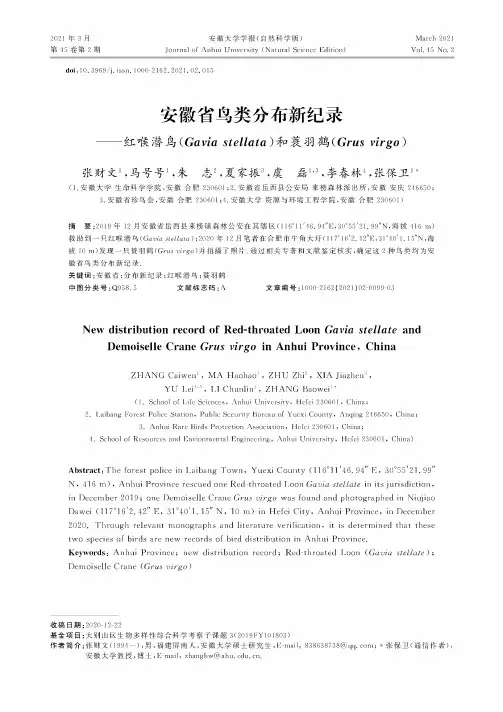
2021年3月第45卷第2期安徽大学学报(自然科学版)JournalofAnhuiUniversity(NaturalScienceEdition)March2021Vol.45No.2doi:10.3969/j.issn.1000-2162.2021.02.015安徽省鸟类分布新纪录----红喉潜鸟(G avi a stellata)和蓑羽鹤(Gm s virgo)张财文X马号号X朱志夏家振3,虞磊13,李春林4,张保卫1* (1安徽大学生命科学学院,安徽合肥230601;.安徽省岳西县公安局来榜森林派出所,安徽安庆246650;3.安徽省珍鸟会,安徽合肥230601;.安徽大学资源与环境工程学院,安徽合肥230601.)摘要:2019年12月安徽省岳西县来榜镇森林公安在其辖区(116T146.94E,30552199"N,海拔416m)救助到一只红喉潜鸟(GaVa t l aa);2020年12月笔者在合肥市牛角大圩(117°162.42"E,31°40115"N,海拔10m)发现一只蓑羽鹤(Gu virgo)并拍摄了照片.通过相关专著和文献鉴定核实,确定这2种鸟类均为安徽省鸟类分布新纪录•关键词:安徽省;分布新纪录;红喉潜鸟;蓑羽鹤中图分类号:Q9585文献标志码:A文章编号:1000-2162(2021)02-0099-03New distribution record of Red-throated Loon Gavia stellate and Demoiselle Crane Grus virgo in Anhui Province,ChinaZHANG Caiwen1,MA Haohao1,ZHU Zhi2,XIA Jiazhen3,YU Lei13,LI Chunlin4,ZHANG Baowei1*(1.School of Life Sciences,Anhui University,Hefei230601,China;ibang Forest Police Station,Public Security Bureau of Yuexi County,Anqing246650,China;3.Anhui Rare Birds Protection Association,Hefei230601,China;4.School of Resources and Envionmental Engineering,Anhui University,Heffi230601,China.)Abstract:The forest,police in Taibang Town,Yuexi County(116°11‘46.94"E,30°55‘21.99"N,416m),Anhui Province rescued one Red-throated Loon Gavia stellate in its j urisdiction, in December2019;one Demoiselle Crane Grus virgo was found and photographed in Niujiao Dawei(117°162.42"E,31°40‘1.15"N,10m)in Hefei City,Anhui Province,in December 2020.Through relevant,monographs and liteature verification,it.is determined that,these t.wo species of birds arc new records of bird distribution in Anhui Province.Keywords:Anhui Province;new distribution record;Red-throated Loon(Gavia stellate);Demoiselle Crane{Grus virgo)收稿日期:2020-12-22基金项目:大别山区生物多样性综合科学考察子课题3C2019FY101803.)作者简介:张财文(1994—),男,福建屏南人,安徽大学硕士研究生,E-mail:838638738®;*张保卫(通信作者)安徽大学教授,博士,E-mail:zhangbw@.100安徽大学学报(自然科学版)第45卷安徽省是我国南北气候过渡地带,境内河流纵横,湖泊众多,湿地广袤,生态环境类型多样化,自然条件优越[]•安徽省是动物区系的古北界和东洋界的交汇区域,南北动物区系差异明显[]•就鸟类而言,该省地处“东亚-澳大利亚”候鸟迁徙通道上,每年有大量候鸟迁徙过境,优越的生态环境为鸟类的栖息繁衍提供了得天独厚的条件[].截至2020年7月,全省共有鸟类纪录457种[-11].2019年12月至2020年12月,笔者在进行大别山及周边地区陆生脊椎动物多样性调查时,分别于安庆市岳西县来榜村和合肥市牛角大圩记录到红喉潜鸟和蓑羽鹤,并拍摄到清晰的照片,经查阅文献资料核实,这两种鸟类均为安徽省鸟类分布新纪录•1红喉潜鸟(G avi a stellata)2019年12月2日,安徽省岳西县来榜镇森林公安在来榜河的河滩农田湿地上(116°1146.94〃E, 30°5521.99〃N,海拔416m)发现一只受伤的红喉潜鸟(图1).12月3日,岳西县林业局野生动物保护站对该物种进行了详细的检查,检查结果表明该鸟状况良好,随后在衙前河畔选择合适的生境对其进行放生.图1红喉潜鸟(G a ia朱志摄)来榜镇位于大别山腹地,安徽省西南部,该区域年降水量大,气候湿润,植被类型以亚热带湿润常绿落叶阔叶混交林为主;境内群峰叠嶂,形成多样的独特生态环境,有着极为丰富的野生动植物资源•红喉潜鸟为潜鸟目(Gaviformes)潜鸟科(Gavidae)的一种水鸟,体型似鸭,头型小,颈细长,嘴黑色略上扬;头顶灰褐色,颏、喉、颈侧和脸及下体白色,背部黑色且散布有较多白色纵纹"5].该物种主要繁殖于欧亚大陆、北美大陆北纬50°以北的北极区海域,冬季南迁至北纬30°左右的沿海地区弘7].国内主要栖息于沿海省份的海湾、河口、湖泊和水库等地区"5]•本次在安徽省仅记录到一只个体,据发现者描述,疑该鸟是在空中飞翔时被猛禽击落,属零星分布,其偶然出现在安徽的原因尚不太清楚,需要在以后调查中加以关注•2蓑羽鹤(Grus virgo)2020年12月6日,在合肥市牛角大圩内的草甸沼泽中(117°16242〃E,31°401.15〃N,海拔10m)观测并拍摄到1只蓑羽鹤(图2).图2蓑羽鹤(Grus virgo)(夏家振摄)第2期张财文,等:安徽省鸟类分布新纪录101合肥市牛角大圩是一座古老的圩区,该圩位于派河口左岸,毗邻巢湖西畔,因整体形态似牛角而得名.圩内地面主要以沟塘和水田为主,有较为开阔的平原草地、草甸沼泽和苇塘,该圩人为干扰较弱,湿地自然形态保留较为完整,水生动植物资源较为丰富.蓑羽鹤隶属于鹤形目(Gruiformes)鹤科(Gruidae),属国家二级重点保护动物,是世界现存15种鹤中体型最小的一种[-5].该物种体型纤瘦,头、颈和胸以黑色为主,头顶白色,眼后有白色长羽延长并分垂,胸部黑羽也延长至胸部以下,三级飞羽延长但不浓密,延长部分覆盖尾端[45],蓑羽鹤在国内主要繁殖于黑龙江、吉林、辽宁、新疆和内蒙古等省份,迁徙经华北和中部地区的北京、天津、河北、河南、陕西、青海、湖北、江西、台湾和四川等省份,越冬于西藏南部和云南东北部[-7].该次仅发现一只成年个体,猜测安徽省可能为其迁徙通道的边缘地区,后期应持续加以关注监测.3讨论经查阅《中国鸟类种和亚种分类名录大全》《中国鸟类分类与分布名录(第三版)》《安徽鸟类图志》《安徽省鸟类分布名录与图鉴》》中国鸟类野外手册》和《中国鸟类图鉴》等相关专著及文献[27],确认红喉潜鸟和蓑羽鹤这2种鸟类均为安徽省鸟类分布新纪录.自2017年以来,安徽省先后发现了黑脸琵鹭(Plat lea minor)、沙丘鹤{Grus canadensis)、黑雁(Branta benil)黄眉姬鹟(Ficedula narcissina)、鳞头树莺(Urosphena squameieps)黑眉柳莺(Phylloscopus ricketti)A红颈苇M(Emberiza yessoensis)栗头鹟莺(Seicercus castanieps)、赤嘴潜鸭(Nett a rufina)A叉尾太阳鸟(.Aethopyga christinae)和叽喳柳莺(.Phylloscopus collybita)等11种鸟类新纪录[811].从地理分布上来看,红喉潜鸟主要繁殖于北极苔原地区,迁徙期间和冬季通常栖息于沿海海域、海湾及河口地区,以鱼类为主要食物.安徽省地处内陆,不是该物种的正常栖息地,根据目击者描述,疑该鸟为迁徙途中被猛禽击落迫降于本地,其在安徽省的居留型尚不清楚,在后期的鸟类调查中有待进一步观察.蓑羽鹤通常繁殖于我国东北、内蒙古鄂尔多斯高原及西北地区,冬季迁徙时经过青藏高原,甚至可以飞越喜马拉雅山,在我国主要越冬于西南部.蓑羽鹤在迁徙过程中也有少部分个体出现在我国东部,相邻的湖北省、河南省和江西省均有其分布记录,此次发现填补了蓑羽鹤在东部分布的空白,后期应持续加以监测.近年来,随着我国生态文明的建设,安徽省生态环境得到了改善,爱护环境的理念已深入人心,同时该省观鸟爱好者的数量也在逐年增加.安徽省生态环境的日益改善和观鸟爱好者的增加是导致该省鸟类新纪录越来越多的主要原因.越来越多的新纪录,表明该省生物多样性保护和生态文明建设已取得成效.参考文献:[1]王岐山.安徽动物地理区划[].安徽大学学报(自然科学版),1986():455&[2]吴海龙,顾长明.安徽鸟类图志[M].芜湖:安徽师范大学出版社,2017.[3]侯银续.安徽省鸟类分布名录与图鉴[M].合肥:黄山书社,201&[4]约翰•马敬能,卡伦•菲普斯,何芬奇.中国鸟类野外手册[M].长沙:湖南教育出版社,2000.[5]赵欣如.中国鸟类图鉴[M].北京:商务印书馆,201&[6]郑作新.中国鸟类种和亚种分类名录大全[M].2版.北京:科学出版社,2000.[7]郑光美.中国鸟类分类与分布名录[M].3版.北京:科学出版社,2017.[8]赵凯,张宏,顾长明,等.安徽省七种鸟类新纪录[].动物学杂志,2017,52():877-881.[9]杨森,李春林,杨阳,等.安徽省鸟类新纪录——栗头鹟莺和赤嘴潜鸭[].四川动物,2017,36():187.[10]赵彬彬,桂正文,邹宏硕,等.安徽省鸟类新纪录——叉尾太阳鸟[J].四川动物,2018,37():91.[11]张建平,周立志•安徽省鸟类分布新纪录----叽喳柳莺(.phylloscopus collybta){}].安徽大学学报(自然科学版),2020,44():8687.(责任编辑于敏)。
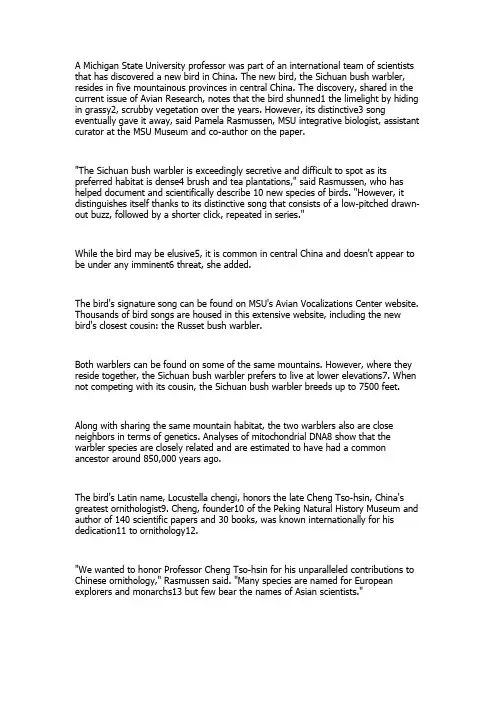
A Michigan State University professor was part of an international team of scientists that has discovered a new bird in China. The new bird, the Sichuan bush warbler, resides in five mountainous provinces in central China. The discovery, shared in thecurrent issue of Avian Research, notes that the bird shunned1 the limelight by hiding in grassy2, scrubby vegetation over the years. However, its distinctive3 song eventually gave it away, said Pamela Rasmussen, MSU integrative biologist, assistant curator at the MSU Museum and co-author on the paper."The Sichuan bush warbler is exceedingly secretive and difficult to spot as its preferred habitat is dense4 brush and tea plantations," said Rasmussen, who has helped document and scientifically describe 10 new species of birds. "However, it distinguishes itself thanks to its distinctive song that consists of a low-pitched drawn-out buzz, followed by a shorter click, repeated in series."While the bird may be elusive5, it is common in central China and doesn't appear to be under any imminent6 threat, she added.The bird's signature song can be found on MSU's Avian Vocalizations Center website. Thousands of bird songs are housed in this extensive website, including the new bird's closest cousin: the Russet bush warbler.Both warblers can be found on some of the same mountains. However, where they reside together, the Sichuan bush warbler prefers to live at lower elevations7. When not competing with its cousin, the Sichuan bush warbler breeds up to 7500 feet.Along with sharing the same mountain habitat, the two warblers also are close neighbors in terms of genetics. Analyses of mitochondrial DNA8 show that the warbler species are closely related and are estimated to have had a common ancestor around 850,000 years ago.The bird's Latin name, Locustella chengi, honors the late Cheng Tso-hsin, China's greatest ornithologist9. Cheng, founder10 of the Peking Natural History Museum and author of 140 scientific papers and 30 books, was known internationally for his dedication11 to ornithology12."We wanted to honor Professor Cheng Tso-hsin for his unparalleled contributions to Chinese ornithology," Rasmussen said. "Many species are named for European explorers and monarchs13 but few bear the names of Asian scientists."词汇解析:1 shunnedv.避开,回避,避免( shun的过去式和过去分词 )参考例句:She was shunned by her family when she remarried. 她再婚后家里人都躲着她。

中国鸟类新纪录──棕薮鸲
侯兰新;贾泽信
【期刊名称】《动物学杂志》
【年(卷),期】1998(33)4
【摘要】中国鸟类新纪录———棕薮鸲侯兰新(西北民族学院动物科学系兰州730030)贾泽信(中国科学院新疆生物土壤沙漠研究所乌鲁木齐830011)关键词鸟类新纪录棕薮鸲作者于1995年5月28日,在新疆阜康县采集到一号鸟类标本,经查阅资料[1~4],确认为中国...
【总页数】2页(P43-44)
【关键词】鸟类;新纪录;棕薮鸲
【作者】侯兰新;贾泽信
【作者单位】西北民族学院动物科学系;中国科学院新疆生物土壤沙漠研究所
【正文语种】中文
【中图分类】Q959.7
【相关文献】
1.重庆市鸟类新纪录3种——灰喉山椒鸟、蓝大翅鸲和棕胸蓝姬鹟 [J], 胥执清
2.甘肃裕河省级自然保护区3种雀形目鸟类新纪录——褐头鹪莺、棕尾褐鹟、棕
眉柳莺 [J], 赵喜军;白永兴;刘建军;李辉;马小强
3.山东省鸟类新纪录——白喉红尾鸲、高原岩鹨 [J], 高晓冬; 孙桂玲; 刘兆瑞; 韦铭; 张洪海
4.山东省鸟类新纪录——白喉红尾鸲、高原岩鹨 [J], 高晓冬; 孙桂玲; 刘兆瑞; 韦铭; 张洪海
5.浙江省鸟类新纪录——赭红尾鸲 [J], 丁鹏; 陈冠; 范忠勇
因版权原因,仅展示原文概要,查看原文内容请购买。
江苏省鸟类新纪录白鹇丁晶晶;徐惠强;熊天石;王雪峰;王金海;李茂金;曹骁翔;常青【摘要】2016年6~11月,利用红外相机开展江苏南部丘陵山区野生动物监测的过程中,在宜兴林场和龙潭林场多个监测点均拍到白鹇雌雄鸟的影像,栖息地大多以常绿落叶阔叶混交林和毛竹林为主.查阅相关文献,证实白鹇为江苏省鸟类新纪录,由此白鹇在中国境内的分布也进一步向北推移.【期刊名称】《野生动物》【年(卷),期】2017(038)002【总页数】2页(P322-323)【关键词】白鹇;江苏;鸟类新纪录【作者】丁晶晶;徐惠强;熊天石;王雪峰;王金海;李茂金;曹骁翔;常青【作者单位】江苏省林业科学研究院,南京,211153;江苏省野生动植物保护站,南京,210036;江苏省野生动植物保护站,南京,210036;溧阳市龙潭林场,常州,213331;宜兴市林场,无锡,214200;溧阳市龙潭林场,常州,213331;宜兴市林场,无锡,214200;南京师范大学生命科学学院,南京,210023【正文语种】中文【中图分类】Q958.1稿件运行过程2016年3月开始,江苏省林业科学研究院与南京师范大学在江苏南部丘陵山区利用红外相机联合开展了野生动物资源监测。
2016年6月,在宜兴林场的YB 02监测点(N 31°14.569′,E 119°43.956′,海拔193 m)、YA 02监测点(N 31°14.706′,E 119°44.219′,海拔199 m)拍摄到白鹇(Lophura nycthemera)雄鸟亚成体的照片(图1)。
2016年10~11月,在龙潭林场LA 05(N 31°15.357′,E 119°28.375′,海拔220 m)和LA 07(N 31°15.342′,E 119°28.344′,海拔230 m)监测位点的红外相机拍到白鹇影像(图2),其中LA 05号位点先后4次拍到2雌1雄,LA 07号位点先后2次拍到白鹇雄鸟的影像。
中国鸟类新纪录种--长尾贼鸥
常家传
【期刊名称】《野生动物》
【年(卷),期】1989(000)004
【摘要】@@ 最近东北林业大学得到1只长尾贼鸥(Stercorarius longicaudus)成年雄性标本,在我国是首次纪录.采集地:福建省闽侯县.生境:近海河流的沙滩上,单只活动.采集日期:1988年6月5日.
【总页数】1页(P43)
【作者】常家传
【作者单位】无
【正文语种】中文
【相关文献】
1.长尾属线虫中国新纪录种的记述(滑刃目,长尾科) [J], 冯桂芳
2.江苏鸟类一个科的新记录——贼鸥科 [J], 章麟;Remco Steggerda;Tapio Aalto
3.内蒙古鸟类新纪录——短尾贼鸥Stercorarius parasiticus [J], 赵格日乐图;乌云毕力格;王明元
4.云南鸟类新纪录中贼鸥现身大理剑湖湿地 [J], 张望星(文/图);段海成(文/图)
5.内蒙古鸟类新纪录:中贼鸥 [J], 徐英;杨贵生;刘莹;王红霞;张世峰;张莉;邢莲莲
因版权原因,仅展示原文概要,查看原文内容请购买。
中国鸟类一新记录——大长嘴地鸫
罗平钊;王吉衣;韩联宪;张国良
【期刊名称】《四川动物》
【年(卷),期】2007(26)3
【摘要】2007年2月4日12:30左右,在云南省德宏傣族景颇族自治州瑞丽市莫里(97°50’E,24°01’N,海拔900m)瀑布进行观鸟活动时,于瀑布前约50m的林缘多石小溪旁用Olympus 8×42和Swarovski EL 8.5×42双筒望远镜观察到地鸫一只,观察时间约10min,并拍摄下照片。
经鉴定是大长嘴地鸫
(Z00thera monticola),为中国鸟类新记录。
【总页数】2页(P489,封2)
【作者】罗平钊;王吉衣;韩联宪;张国良
【作者单位】四川大学高分子科学与工程学院,成都,610065;上海野鸟会;西南林学院保护生物学院;成都观鸟会
【正文语种】中文
【中图分类】Q959.7
【相关文献】
1.中国大蚊科一新记录属及一新记录种(双翅目,大蚊总科) [J], 何翔;刘启飞;杨定;彭宏鹏;彭凌飞
2.重庆市鸟类一新纪录——橙头地鸫 Zoothera citrina (Latham) [J], 胥执清
3.四川鸟类一新记录——绿胸八色鸫 [J], 王育章;胡锦矗;吴天勋;余志伟
4.陕西省鸟类新记录——长嘴半蹼鹬 [J], 臧晓博;姚东武;高国哲;杨亚桥
5.福建省鸟类新记录——灰翅鸫 [J], 梁晖; 罗萧; 马良; 陈光
因版权原因,仅展示原文概要,查看原文内容请购买。
中国东北鸟类新纪录—凤头树燕和发冠卷尾
周明;李明育;罗兴艳;张宇;孙忠凤;张晶;胡天瑶;色音呼
【期刊名称】《内蒙古林业调查设计》
【年(卷),期】2018(041)002
【摘要】2011年1月至2017年10月,在莫尔道嘎发现头树燕和发冠卷,经查阅相关资料,认定为东北地区鸟类新纪录.
【总页数】3页(P23-24,78)
【作者】周明;李明育;罗兴艳;张宇;孙忠凤;张晶;胡天瑶;色音呼
【作者单位】内蒙古额尔古纳国家级自然保护区管理局,额尔古纳 022191;内蒙古额尔古纳国家级自然保护区管理局,额尔古纳 022191;内蒙古额尔古纳国家级自然保护区管理局,额尔古纳 022191;内蒙古额尔古纳国家级自然保护区管理局,额尔古纳 022191;内蒙古额尔古纳国家级自然保护区管理局,额尔古纳 022191;内蒙古额尔古纳国家级自然保护区管理局,额尔古纳 022191;内蒙古额尔古纳国家级自然保护区管理局,额尔古纳 022191;内蒙古额尔古纳国家级自然保护区管理局,额尔古纳022191
【正文语种】中文
【中图分类】S718.63
【相关文献】
1.青海鸟类二新纪录——白胸苦恶鸟、发冠卷尾 [J], 陈振宁;鲍敏;王舰艇;王岳邦;曾阳;张营;段培
2.中华凤头燕鸥育雏数量创新纪录--我国人工引导鸟类选择繁殖地试验再获成功[J], 陈水华;范忠勇;陆祎玮
3.雷公山自然保护区鸟类新纪录——褐耳鹰和凤头鹰 [J], 黄松;李登江;王泽文
4.黑龙江省鸟类新纪录——发冠卷尾 [J], 郭玉民;阳艳岚;韩兴宝;姚恒彪
5.东北鸟类新纪录——红翅凤头鹃 [J], 阳艳岚;董传龙;黄建
因版权原因,仅展示原文概要,查看原文内容请购买。
2012年4月2日,鸟类观察者郭宏先生在乌恰县(北纬39度55分,东经75度15分)海拔2000
米的一个垃圾堆旁发现了一只奇怪的白鸟。
这个地方位于喀什以东大约80公里处。
在专家检查这些照片后,这只白鸟被认定为一只成年的埃及兀鹫(Neophron percnopterus),又名白兀鹫(见图一)。
这是中国鸟类观察者首次拍到此种兀鹫。
记录地点乌恰县距离吉尔吉斯斯坦和塔吉克斯坦的边境线大约110-130公里。
埃及兀鹫被发现于欧洲东南部、非洲北部、西亚和南亚,也包括一些中国的邻国,也就是印度、尼泊尔、巴基斯坦、阿富汗、塔吉克斯坦、吉尔吉斯斯坦和哈萨克斯坦。
这种鸟喜欢群居并且使用陈年老巢。
这个物种在基因上与胡兀鹫(Gypaetus barbatus)关系很近。
埃及兀鹫是一种中到大型的鸟类(长为56-6齤4厘米);它的全身呈白色而飞羽为黑色,有着一个带有细长鸟喙的小脑袋和楔形的尾巴(见图2)。
它们有时用石头击破蛋壳,这是猛禽懂得如何在这种情况下使用工具的一个罕见例子。
事实上这并不是在新疆的第一次记录。
大约在11年前的伊犁地区(北纬49度37分,东经82度25分),Jesper Hornskov报道了一次此物种的观鸟记录
(Hornskov,未出版;马,2001)。
然而,这次观察记录的报告并没有相关的照片,因此它的出现在当时没有证据证实。
很明显,这是中国关于这种鸟的第一次记录(未被程列出,1987,2000;马,1995;严等,1995;MacKinnon等,2000;郑,2001),尽管此前de Schauensee(1984)指出“(这个物种)有可能出现在新疆天山一带”。
Flint等(1984)在哈萨克斯坦记录了此物种并且绘出它出现在延伸到新疆边境的大约北纬45度的地区。
郭宏先生拍了约40张关于这次记录的清晰照片,为中国鸟类的新纪录提供了强有力的证据。
这初步认定为是指名亚种Neophron percnopterus percnopterus。